The Stirling Engine Background
Research on the history of Stirling engine, the different types of solar energy (photovoltaic and solar thermal), and the working principles of Stirling engines. Includes a detailed explanation of a solar thermal Stirling engine system and the types of Stirling engines (Alpha, Beta, and Gamma). Also includes advantages, disadvantages, and pictures.
Added on 2022-08-24
The Stirling Engine Background
Research on the history of Stirling engine, the different types of solar energy (photovoltaic and solar thermal), and the working principles of Stirling engines. Includes a detailed explanation of a solar thermal Stirling engine system and the types of Stirling engines (Alpha, Beta, and Gamma). Also includes advantages, disadvantages, and pictures.
Added on 2022-08-24
STIRLING ENGINE
Stirling Engine Background
The engine was discovered by Robert Stirling (Scotland minister) in the year
1816.He was hoping on finding the efficient and safe way of substituting the
steam engine. The engine was incorporated with the features of phase shift
between the piston and displacer in form of reversed heat engine. The engine also
included the cyclic of cooling and heating of internal gas by use of external source
of heat. Stirling initially regarded the sterling engine as a continuous motion
device of 2nd kind i.e. heat energy supplied is transformed to work despite the
original air engine didn’t include the system for cooling. Due to discovery of a
powerful internal heating engine in the 19th century, Stirling discovery was
abandoned. The steam engine was introduced, even though the Stirling engine had
more benefits compared to steam engine. The operational cost of Stirling engine
were relatively low compared to that of steam engine. The steam engines were
also prone to explosions failures. The main limitation of Stirling engine is the
affinity of failing when the cylinder is heated and becomes too hot. Though the
advancement made to reduce the failing tendency, tough competition from other
internal heating engines forced it out of market scene. Recently the researchers
are doing much studies on the Stirling engines, design techniques that are applied
in low temperature Stirling engines [1].
Differences between Photovoltaic solar and solar thermal technologies
PV solar technology involves conversion of solar radiations (sunlight) to D.C
electricity by use of semiconductors. When the solar hits semiconductors with PV

cell, the electrons are dislodged to produce electric current. The technology is
usually employed on solar panels. Photovoltaic cells are connected to another and
attached to a module .Multiple segments are wired together forming arrays, which
is scaled down to yield the power required. Solar thermal technology involves
harvesting solar energy for heat (thermal energy).The technology consists of
parabolic or flat collectors which concentrates the solar radiation by use of lenses
and mirrors. The process utilizes solar energy to provide heat for water heating,
space heating, cooking, and crop drying [2].
Installation
PV solar
Photovoltaic solar system consists of solar module, solar inverter mounting
system and computerized controller. Solar module produces Dc electricity from
solar radiations .Inverter converts produced electricity into alternating current
which is used domestically. Computerized controller manages the system and
ensures maximum performance .For off-grid system the battery is used. Solar
modules are mounted at the roof tops so that the panel receives maximum solar
radiations. Nevertheless .if the roof top installation is not applicable, the panels
are mounted on the ground where no objects blocking the sunlight. The solar
panels are installed using the following steps;
a. Scaffold set up –Scaffolding is erected to guarantee safety for the whole
process of installation.
b. Installation of panel mounts-The mounting system is set up to support the
base of the panel. The mounting system is tilted in an angle that ranges
between 18o to 36o for maximum solar radiation exposure.
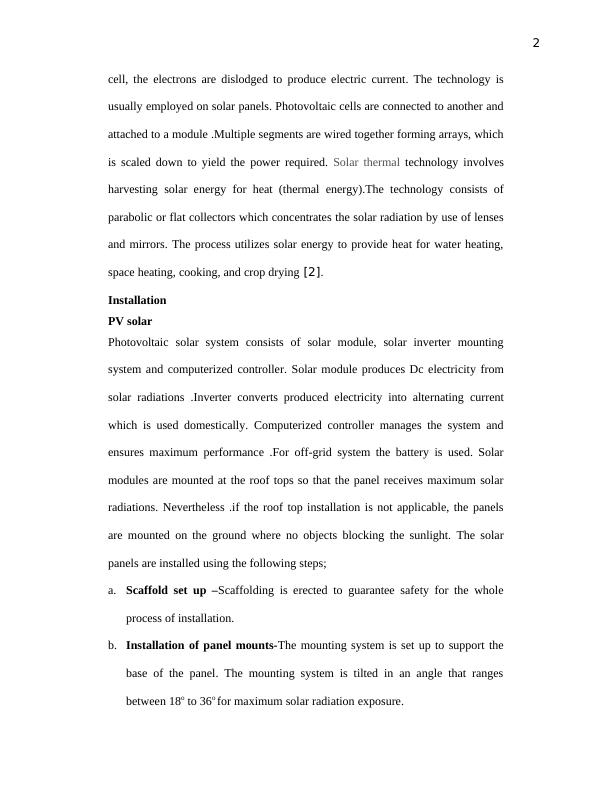
c. Installation of solar module – solar panels are fitted on the mounting
structure. The nuts and bolts are tightened to make the module to be stable.
d. Wiring the solar panels –Electrical wiring by use of MC4 connectors is
done.
e. Installation of solar inverter- The inverter is connected to the system. It is
installed indoor or outdoor near the main panel. Inverters are most efficient
when reserved in a cooler place.
f. Bonding the solar inverter and battery –The solar inverter is connected to
the battery. The battery acts as a storage system for the system.
g. Connection of the inverter to consumer unit. –The inverter is connected to
consumer unit to produce electricity. A meter is connected to the monitor to
measure the actual electricity amount produced by the panel.
h. Start and test of system –This is the final step of the installation which
switches on power and test the installed system [3].
Solar thermal
Solar thermal installation involves a number of steps in connecting the system
until it works effectively. Components connected involves storage tank, evacuated
tube collector, pump station, heat transfer fluid, controller, heat dissipation and
solar flex. The evacuated collector is installed on top of roofs to maximize the
amount of solar radiation absorbed. The steps followed in installation includes;
a. Marking the roof penetrations-Outlining is done by use of marking pen or
chalk on where the tube is to be attached on top roof.
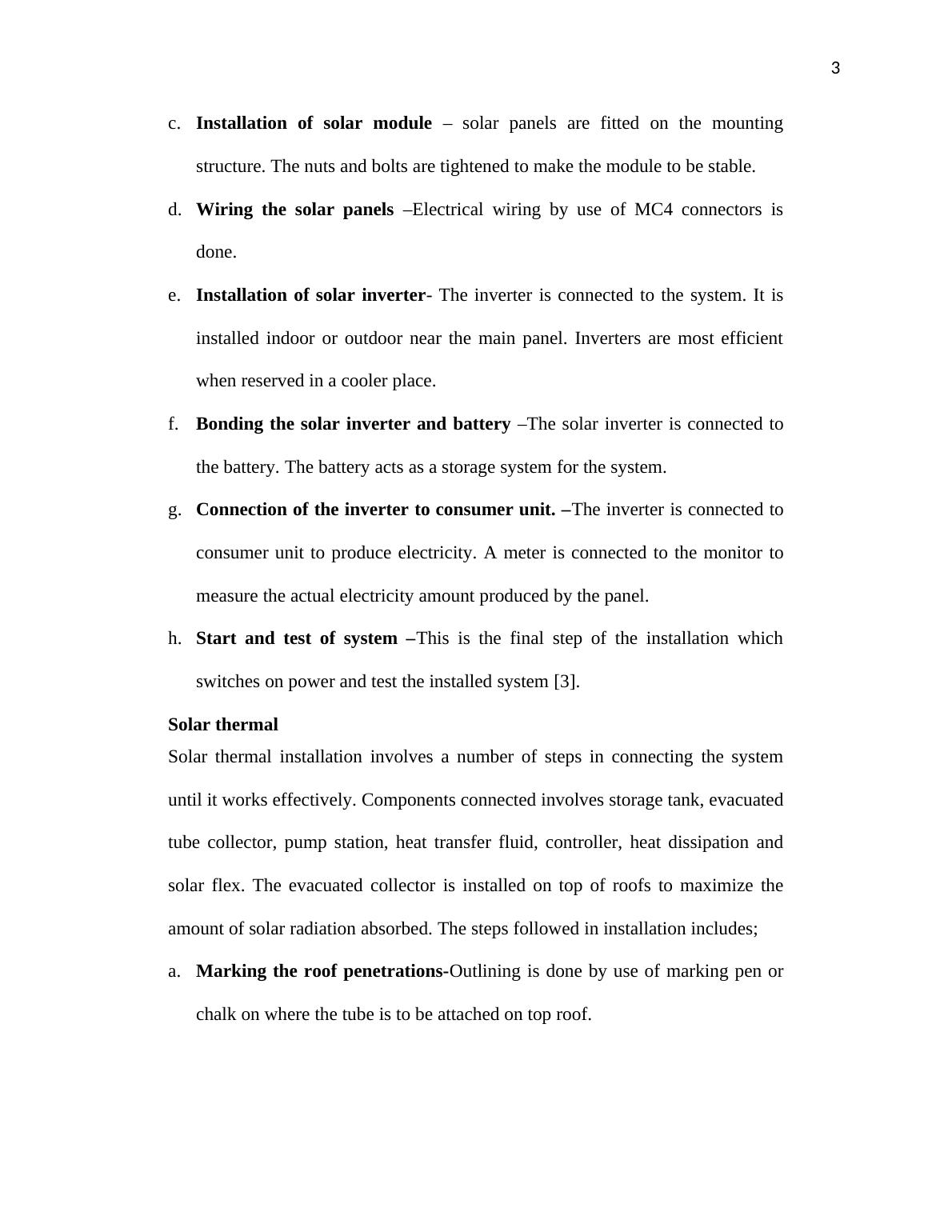
b. Location of rafters –Mark off along the pen marking lines to show where the
rafters intersect, usually the spacing of 12" or 16" is used. For each evacuated
tube the intersection is chosen to match the mounting marks.
c. Mounting and assembly of frame- Penetration points marked are screwed by
a frame along with rubber band to rafters by using 3/8 x 3 1/2 lag screws
of stainless steel.
d. Collector manifold and connection-The manifold is attached to the
assembled frame and it rests on clips on top of the frame. There are 3 clips
which slides back the manifold, and bolted into place to secure it to the frame
without penetration.
e. Heat dissipation /installation of flush mount – Roof trusses are located at
16" or 24" on the marked center and then screwed by use of
lag bolt support in 5/8" socket.
f. Angle frame installation –using 6" in length threated rod with
threated nuts followed by nylon washer. The rod can be
replaced with 2 ½” bolt.
g. Valve installation diversion –Thermostatic diversion valve is used to close
and open the flow to and fro heat dissipater. The process is carried out without
power and valve is heat driven .The valve opens when a given temperature in
the loop is reached, permitting flow through dissipation loop.
h. Storage tank and pump installation –The storage tank is positioned in a
place near the appropriate power supply for the backup. The pump
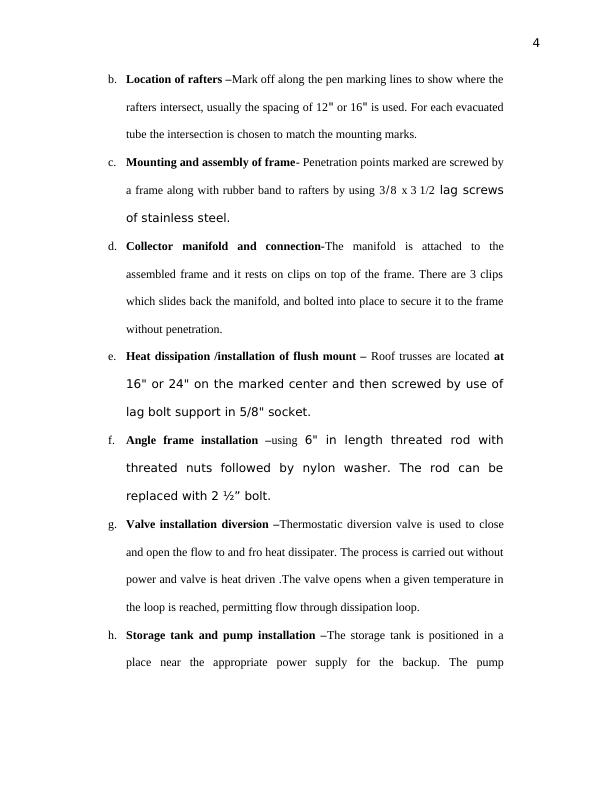
components are re-assembled to brackets .Starting with installation of cover
over mounting bracket [4].
i. Installation of expansion tank- The expansion tank brackets are amounted in
a suitable location near to the pump station. Brass double valves is connected
to expansion tank by use of green washers.
j. Controller installation -Solar controller is mounted to the pump station front.
Controller routes power cord is mounted at the lower right insulation hole.
Temperature probe is fastened to the sensor at the bottom tank.
k. Filling and flushing test-Faucet of hot water is 1st opened within the
facilities. Then water isolation valve is opened to solar tank. After the filling,
the faucets are closed and inspection of threated fitting is done and joints for
leakages are soldered. Then the system is flushed to test for workability.
l. Purging air installation-purging air controller is installed and they are
programmed thus, the do not require adjustments in their application.
m. Set of flow rate –Pump flowing rate is set by use of site gage situated at the
bottom of the pump. The gage shows the flow rate [3].
Fig 1.Photovoltaic solar installation steps [5].
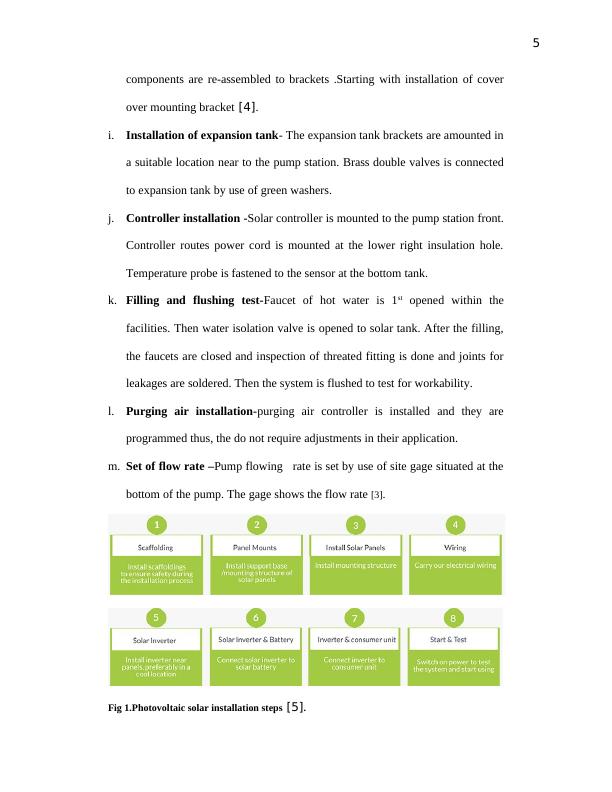
Fig 2.solar thermal station. [6]
Stirling Engine operation.
It comprises of immovable mass of a fluid that contains helium, hydrogen and air.
In usual operation, the sterling engine is wrapped and no entry or exit of the gas.
The closed system doesn’t need valves not like other piston engines. The engine
cycles via 4 main that includes; heating, expansion cooling and compression.
These processes are achieved by the motion of the fluid (gas) between cold and
hot heat- exchangers. The hot exchanger is in connected with external sources of
heat such as fuel burner while the cold exchanger is connected to external heat
sinks such as air fins. Alteration of gas temperature causes a consistent variation
in fluid pressure, as the piston motion causes the fluid to alternately compressed
and expanded. When the working fluid is heated, the internal pressure increases
and produces power stroke in the power piston. When the working fluid is cooled,
internal pressure drops, thus less work done by piston in gas compression of the
return stroke yielding a disposable energy output [7].
Stirling engine basically applies temperature differences in cold and hot ends in
establishment of fixed mass fluid cycle, expanded through heating and
compressed through cooling, therefore converting heat energy to mechanical
energy. The thermal efficiency of engine is high when the heat difference between
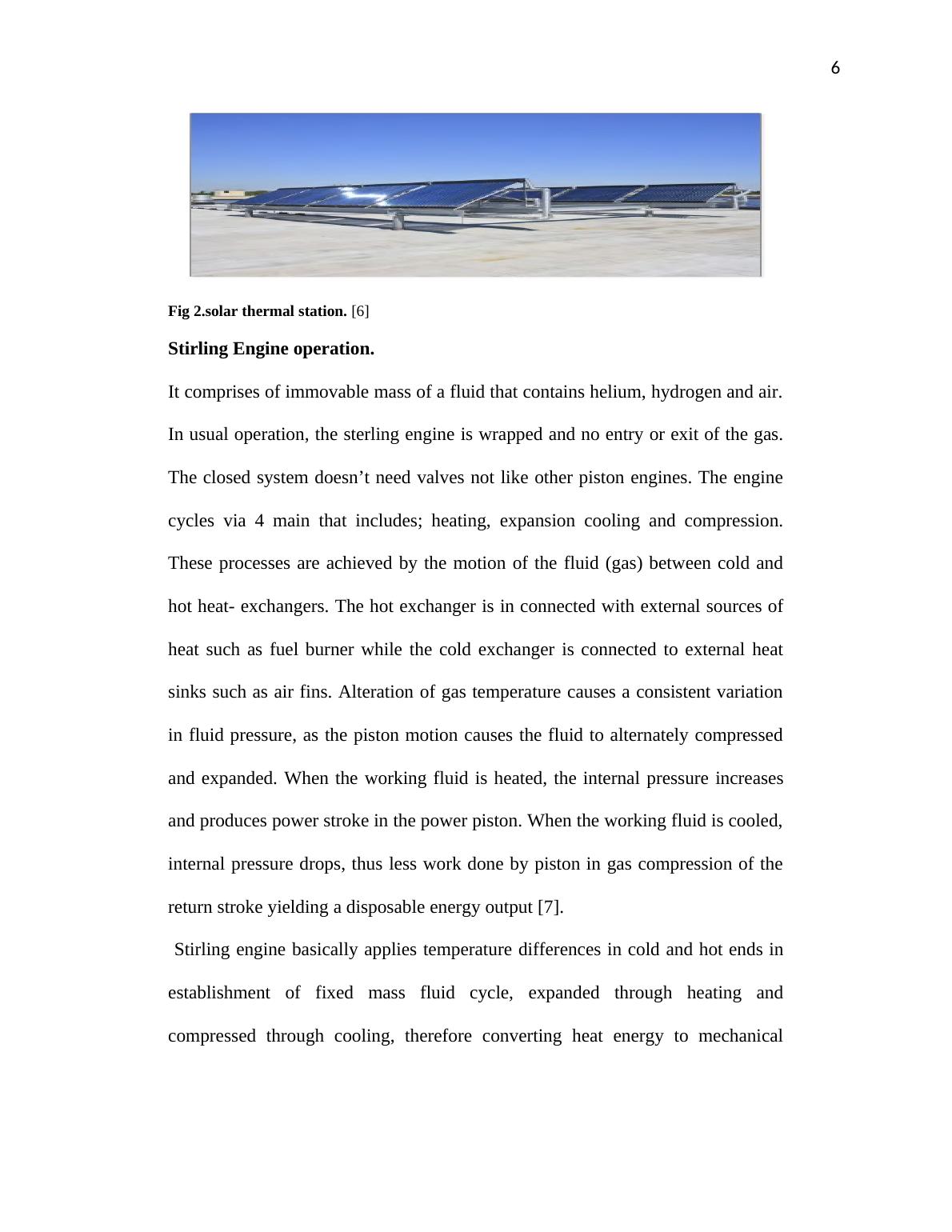
End of preview
Want to access all the pages? Upload your documents or become a member.
